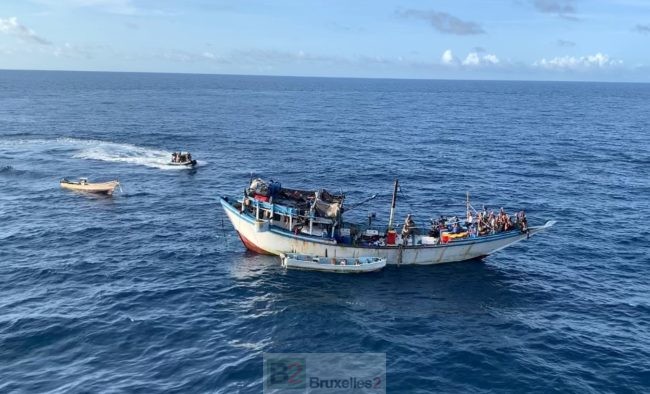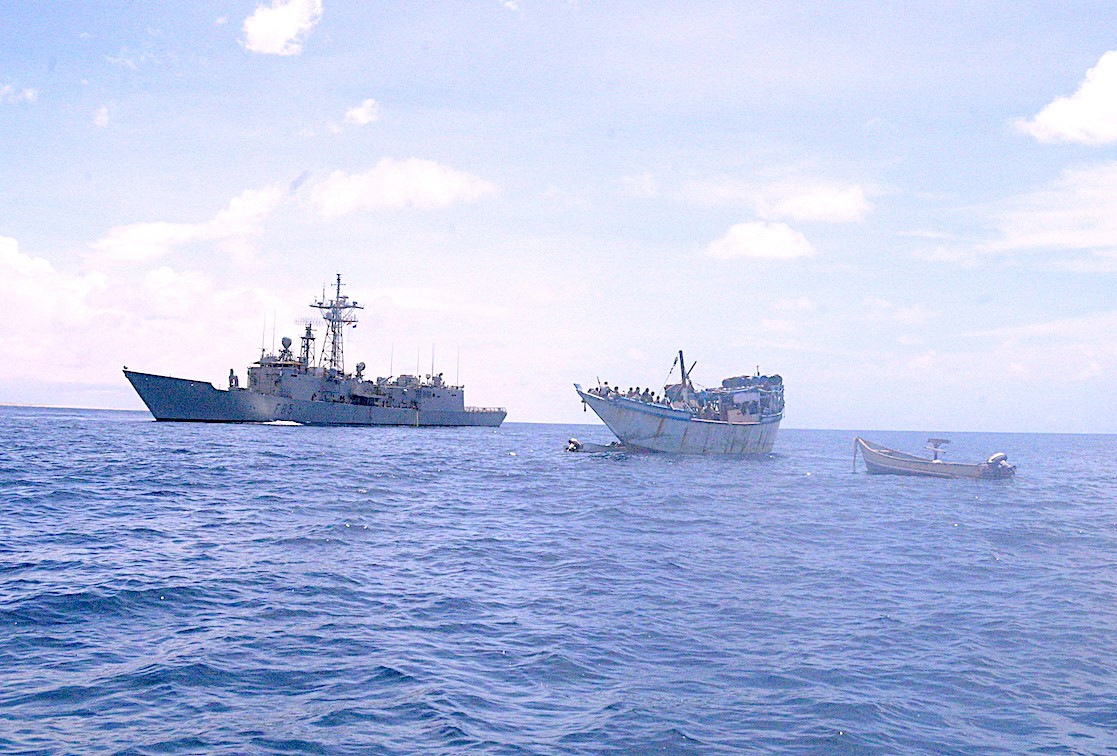The pirates are on the attack again. A mother ship stopped short in the Indian Ocean (v4)
(B2) The Spanish frigate 'Navarra' (F-85), the flagship of the European operation against piracy in the Indian Ocean (EUNAVFOR Atalanta), intercepted, this Tuesday (April 23), a boat Yemeni fishing vessel used by Somali pirates, announced the HQ of Operation Atalanta based in Rota (Spain).

Un dhow hijacked yemeni
It all started in fact four days earlier, Friday (April 19). Five Somali pirates then hijack a Yemeni dhow named 'Al-Azham' in Somali territorial waters near the town of Adale (or Cadaley), north of Mogadishu. On board of dhow, the pirates then set sail for the Somali coast. Destination: a pirate base camp. There, they complete their crew with additional members, according to information obtained by B2.
Two fishing vessels attacked on Sunday
With this reinforcement, the pirates then set sail again, hunting ships. Two days later, on Sunday (April 21), they launched their two skiffs towards a fishing vessel, flying the South Korean flag, the F.V. Adria. This one is not far from the Somali coast of the State of Galmadug, 25 km away (according to our information). The Spanish tuna FV Txori Argi, based in Bermeo (Basque country), which operated in the surrounding area at that time, then approached the F.V. Adria to offer him help. The ships implement several diversionary maneuvers, stemming from the 'good practices' against piracy: by accelerating their speed, and with avoidance maneuvers. The combined action lasts about an hour.
A rocket launcher?
To end it, the pirate skiffs fire on two ships " using what appeared to be a grenade from a rocket launcher » we specify at the HQ of Atalanta. Private Armed Security Teams (PAST) on board the two fishing vessels respond. The attacking skiffs do not wait for their rest and take off. Another fishing vessel, the FV Shin Shuen Far 889, reported having been approached by two skiffs, at 280 nautical miles, off the coast of Somalia. The attacking skiffs withdrew when the onboard security team pointed to guns, with warning shots in support.
In the air and at sea
A German Navy P3 Orion C surveillance plane, based in Djibouti, takes off to reach the area of the attack in order to be able to locate the attackers. Rear Admiral Ricardo A. Hernández López also orders thea spanish frigate Navarre (F-85), which was then in the port of Mombassa, to weigh anchor and reach the area as quickly as possible, to participate in search and interception operations.
The suspect dhow spotted and located
The plane then spotted a dhow towing several skiffs, corresponding to the Yemeni dhow attacked a few days earlier and having led the attack. This information will then be confirmed by a P3 Orion M from the Spanish Navy. THE Navarre, arrived in the area after 28 hours of navigation, locates the suspect dhow as it heads towards the Somali coast, near known pirate camps.
23 hostages freed, five suspects arrested
At dawn, in the most discreet way possible, the teams of Navarra riflemen stormed the dhow and neutralized the attackers. The 23 hostages (the crew of the Yemeni boat) and the ship are freed. " Safe and sound “We specify at the HQ of Atalanta. Five suspected pirates are apprehended.
Questioning about the injured and the transfer
It is not yet known whether any were injured during the attack (1). And their future fate, especially if they will be handed over to a court. This question could be decided soon (2). But what we do know is that the Spanish sailors operated according to the usual procedure in order to be able to carry out this transfer, in complete legal certainty. In particular, they collected testimonies from the crew and evidence of the events. " The operation is still in progress” indicated the staff of the Spanish army this Tuesday shortly before 18 p.m.
Piracy that is not eradicated
« The dismantling of a group of pirates, the release of a hijacked dhow and the attack on two fishing vessels, show that piracy in Somali waters is not eradicated commented Wednesday morning (April 24) Rear Admiral Antonio Martorell, commander of the operation EUNAVFOR Atalanta. " [We] we will continue to act with determination to counter this business ».
The dismantling of the Pirate Group, after the release of the hijacked dhow from which they had carried out attacks on 2 fishing vessels, shows piracy in the waters of Somalia is not erradicated. EUNAVFOR Atalanta will continue acting with determination to counter this matter. pic.twitter.com/defqZN9RnN
—Rear Admiral Antonio Martorell (@OpComd_EUNAVFOR) April 24th
Comment: The new command device tested
This is the first attack, a sort of full-scale test for the new European HQ now based in Spain (read: Operation Atalanta: Rota takes command). It had been a long time since the European naval force had seized and arrested pirates in the act. The last recorded attack dates from October 2018 according to the B2 'piracy' database (read : Pirate ship spotted by Atalanta forces destroyed near Somali coast). But at the time no ship had been captured or pursued. We have to go back to November 2017 to have a similar combined air + sea operation, which resulted in an arrest (read: Two pirate attacks dissected by Rear Admiral Pérez de Nanclares de Badajoz).
(Nicolas Gros-Verheyde)
Read more : The five pirates arrested by the Spaniards transferred to the Seychelles
- Our comment was later confirmed: two of the five arrested suspects were injured. The exact number of pirates on board has yet to be clarified: five pirates indeed attacked the dhow Yemenite. But they benefited from a reinforcement in personnel, then. And to go on the attack aboard two skiffs, not to mention guarding the dhow, the pirates should have been at least a dozen in total, according to the 'norm' of piracy.
- If the Basque tuna was the victim of a shot, Spanish justice could be seized, or even South Korean justice, as has been the case in the past. But you will need to have enough evidence and a link with the country concerned to make the transfer. Otherwise they could be transferred to Somalia. Which is more complicated.
Updated on 24.2 9 am and 30 am with details on the attack + statement from the operation commander, 10 with details on the intervention on board and the collection of evidence


These fishing vessels attacked were in Somali waters? If so, they are plundering Somali fish resources…
Am I to understand that non-Somali vessels are fishing in Somali waters with armed men on board and under the protection of foreign navies? The article lacks details on these points.
The ships attacked were 270 or 280 nautical miles from the coast. It is precise enough as a positioning to indicate that they were not in territorial waters (12 nautical miles) nor in a possible exclusive economic zone (200 nautical miles). As for the Yemeni dhow, its position is actually unspecified. But he did not have armed men as you indicate. And supposing that he engaged in fishing, we are in the context of a fishery of reduced dimension, of local order. Not what to speak of a “looting”.
The very question of HNaillon is a little "unpleasant" for Nicolas, whereas the elements given were clear: the Yemeni dhow transformed punctually into a mother ship (with or without the assistance of the Yemeni crew) was far from the Somali coast because the The objectives of these pirates are obviously not a few nautical miles from the coast.
On the other hand, part of this question ("the plundering of fishery resources") deserves clarification: all European fishing vessels fish outside Somali waters and South Korean or Thai fishing vessels have "true-false ” fishing licenses given by Puntland or Somaliland.
True-false licenses because the Federal Government of Somalia in Mogadischo is challenging the federal states to award these licenses paid annually:
this is the subject that HNaillon could dig into to find out the maritime situation in the area.